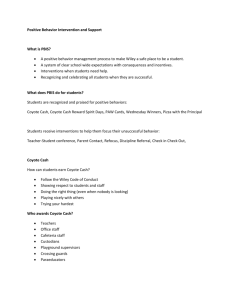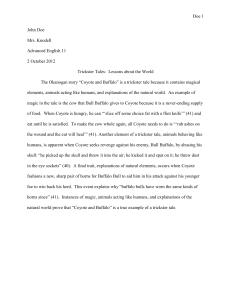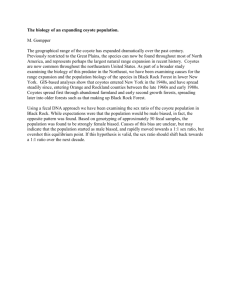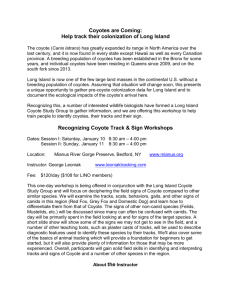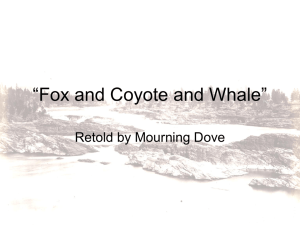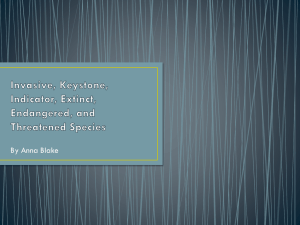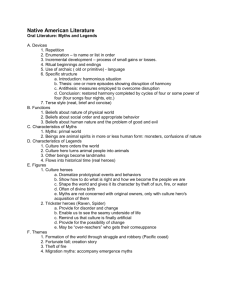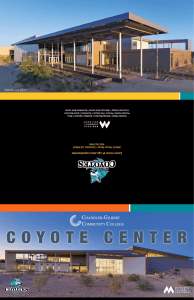e3_Coyote Case Study2000/L&J
advertisement
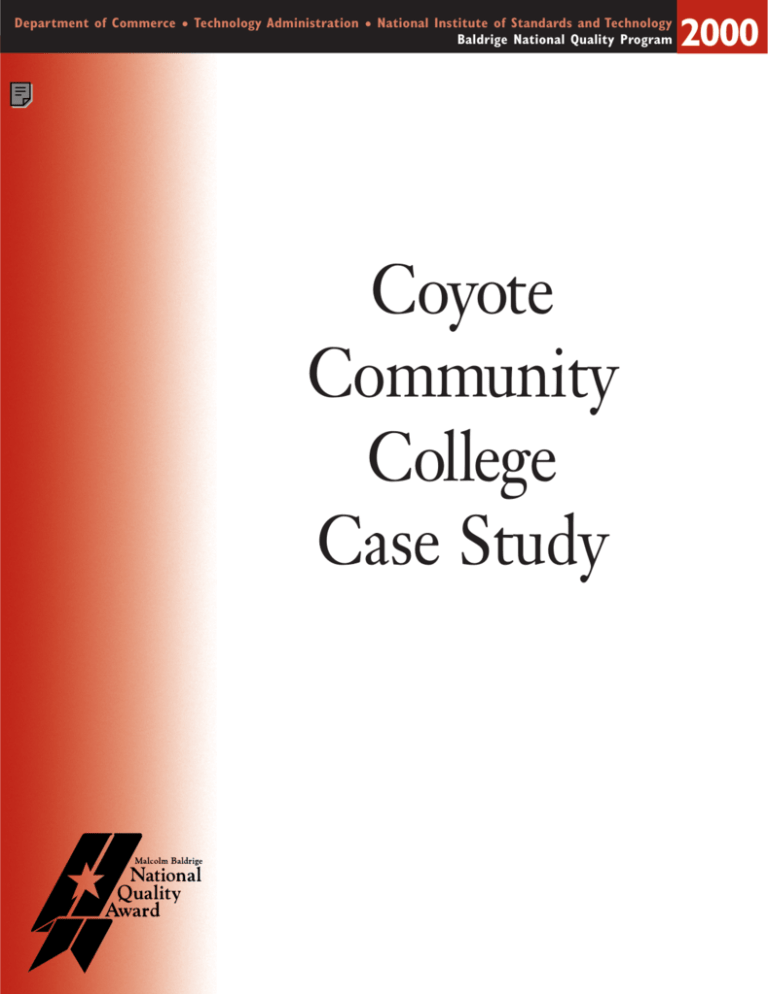
Department of Commerce ● Technology Administration ● National Institute of Standards and Technology Baldrige National Quality Program Coyote Community College Case Study 2000 Organization Overview 1. Basic Description of the Organization paraprofessional fields lead to an Associate of Science (AS) degree or a certificate. Occupational programs also provide retraining and upgrading of skills in these fields so that students are qualified to meet current needs of the labor market. AS degrees are generally not intended for transfer to four-year institutions. Students who do transfer with AS degrees are required to take additional remedial courses as required by each specific degree program. Students may select from 30 occupational programs, including computer technology; computer applications; day care management; nursing; retailing; computer-aided design/computer-aided manufacturing (CAD/CAM); graphic design technology; biotechnology; heating, ventilating and air conditioning (HVAC); hydrological technology; and contract administration. In the area of Developmental Education, Coyote offers General Education Development (GED) preparation courses, courses in English as a Second Language (ESL), and strong remedial courses in math, reading, and writing. Sixty percent of all Coyote students enrolled in traditional college courses enroll in at least one remedial course, and 15 percent enroll in an ESL course. Coyote Community College is a comprehensive, two-year public college that serves and strengthens the greater Albuquerque, New Mexico, community by providing postsecondary education and learning opportunities to all who want to identify and develop their abilities and interests. Since 1968, Coyote’s programs and services have been providing accessible, affordable, high-quality higher education opportunities in a learning environment that encourages challenging, innovative teaching methods and delivery systems that enhance student learning. Coyote is a commuter college with a main campus in downtown Albuquerque and two branch campuses: one located in Bernalillo, 20 miles north of Albuquerque, and the other in Armijo, southeast of downtown Albuquerque. The campus in Albuquerque accounts for 44 percent of Coyote’s enrollment, the Bernalillo campus accounts for 25 percent, and the Armijo campus accounts for 31 percent. With a total enrollment of 19,880 students, Coyote is the largest community college and the second largest statesupported postsecondary institution in New Mexico. As an open access institution, any New Mexico resident who is a high school graduate or Graduate Equivalency Degree (GED) recipient may enroll at Coyote. The college’s tuition rates for state residents are typically 60 percent lower than tuition charged by neighboring colleges or universities. In the area of (2) Workforce Development, Certificate Programs, and Continuing Education, Coyote provides customdesigned, on-site training, courses, and services that meet the needs of local businesses. In partnership with several local employers, Coyote offers contract training for computer networking technicians, water management specialists, office managers, contract administrators, and prison guards. Coyote also offers intensive ESL and remedial English and math courses under contract. In addition, Coyote offers a wide variety of short-term certification courses, such as Network Administrator, Network Engineer, Advanced Office Automation, Systems Engineer, Quality Auditor, Purchasing Manager, and Certified Nursing Assistant, to the general public and by contract. Continuing Education programs address those students who wish to improve professional skills, acquire new skills, or expand their fields of knowledge and general interest. Coyote’s innovative, community-centered educational programs are designed to meet a variety of academic, career, and personal educational goals. Program offerings fall into one of three general areas: (1) General Education, University Transfer Education, and Developmental Education; (2) Workforce Development, Certificate Programs, and Continuing Education; and (3) Community Education and Outreach. The majority of these programs lead to the award of diplomas, degrees, or certificates. Coyote also provides high-quality student support services and resources in collaboration with community agencies to enable students to formulate their goals and pursue them realistically. These services include academic and occupational counseling, job and educational placement services, assistance in obtaining financial aid, and special needs programs. In the area of (3) Community Education and Outreach, Coyote provides programs and community services that offer multicultural, recreational, and community development activities to meet the needs of lifelong learners. These activities, which include a Women in Transition program, the Coyote Cultural Center, an Elder Learning Center, and a day care center, also encourage the use of community college facilities and services by all citizens of the community for educational and cultural purposes. Programs and offerings in the area of (1) General Education, University Transfer Education, and Developmental Education enable students to achieve academic and personal goals, enter the job market, or, in some cases, to successfully transfer to four-year colleges and universities. Coyote offers Associate of Arts (AA) degrees in liberal arts, business administration, education, hotel and restaurant management, computer science, pre-engineering, and biological sciences. AA degrees are intended for students transferring to four-year colleges and universities such that no remedial coursework is required upon transfer. Occupational programs in technical, vocational, and Coyote’s main campus occupies 55 acres near downtown Albuquerque. This includes seven classroom/lab buildings that feature state-of-the-art computer, CAD/CAM, electronics, and science labs. Coyote’s branch campus in Armijo formerly housed a vocational technical high school. This campus now houses labs for the hospitality, HVAC, hydrology, and 1 electronics manufacturing programs. The facility in Bernalillo, which occupies five floors in an office building, offers a variety of classes that primarily serve the Native American population from nearby reservations. Although ESL and remedial classes are available at all three campuses, the Bernalillo campus serves as the college’s ESL/Remedial Center. All sites are able to accommodate the needs of the off-campus students who require occasional use of Coyote’s facilities. All facilities are located within four blocks of a major traffic artery to provide easy commutes for students, faculty, and staff. part-time and recognize the need for higher learning in their personal development. Approximately 44 percent of students enrolled in these curricula receive financial aid from federal, state, or local programs, and 28 percent of these students receive employer reimbursement. (2) There are 8,380 students enrolled in Workforce Development, Certificate Programs, and Continuing Education courses. Most of these curricula involve noncredit contract training and short-term courses. Since a very small portion of Coyote’s state funding is based on the headcount for noncredit students, an FTE equivalent is not calculated for these students. Over 93 percent of the students enrolled in Workforce Development, Certificate Programs, and Continuing Education courses are employed either full- or part-time, and most are seeking new skills that will make them more valuable in the workplace market. Most of these students also desire additional learning to advance within their current skill area and with their current employer. Others want to redirect their careers to a new field. Approximately 84 percent of the tuition costs for students in Workforce Development, Certificate Programs, and Continuing Education are paid by their employers. Principal Types of Students Students at Coyote are divided among (1) those enrolled in traditional college credit degree curricula, (2) those enrolled in noncredit contract training and in short-term certificate courses, and (3) those involved in the community outreach programs. Because of demands placed on their resources and time by employers, family, and others, students tend to pursue Ethnicity White, Non-Hispanic Hispanic Native American African American Other Figure 0-1 Student Ethnicity Percentage 54% 32% 10% 3% 1% (3) Coyote’s Community Education and Outreach programs primarily serve the college’s two-county service area, which has 434,000 taxpaying residents. More than 9 percent of the adult population in the two surrounding counties attends at least one course, program, or event within an academic year. For example, Coyote’s Native American Cultural Celebration, held the last weekend of April, has the second highest attendance of any annual public event in the state, exceeded only by the annual hot air balloon festival. Headcount numbers for Community Education and Outreach programs are not included in Coyote’s total enrollment figures since these programs involve only noncredit courses, programs, and events, and the state does not include these numbers in its funding formula. their education intermittently, and approximately 75 percent of students attend Coyote on a part-time basis. The average age of the students is 28. Women account for 58 percent of Coyote’s enrollment. The breakdown of students by ethnicity is shown in Figure 0-1. Ninety-two percent of the students at Coyote are residents of either Sandoval or Bernalillo counties. The majority of nonresident students come to Coyote through the contract training program. Faculty and Staff Base Enrollment numbers are calculated as a straight headcount. The Full Time Equivalent (FTE) of these enrollment numbers is calculated only for credit courses, as designated under the New Mexico funding formula. FTE is calculated by multiplying the number of students by the number of credit hours taken per student and dividing by 15. Coyote employs 280 full-time faculty, 830 adjunct (part-time) faculty, 40 administrators, and 150 support staff. The faculty are members of the National Education Association union. Fifty percent of full-time faculty hold a master’s degree, 40 percent hold doctoral degrees, and 10 percent hold bachelor’s degrees. Adjunct faculty, many of whom are working in the field in which they teach, hold at least a bachelor’s degree. Seventy-five percent of the administrators hold a master’s degree or higher. (1) There are 11,500 students (7,000 FTE) enrolled in the General Education, University Transfer Education, and Developmental Education curricula. Approximately 27 percent of these students recently graduated from high school, while 65 percent have been out of school for four or more years and are considered First Time In College (FTIC) students. Over 52 percent of the General Education and University Transfer students are using Coyote as a bridge to fouryear degree curricula, while saving significant costs in their education. The remainder of credit students want an Associate Degree as a foundation for entry into the area workforce. Over 75 percent of students enrolled in these curricula work full- or The average length of employment of all faculty and staff at Coyote, including part-time faculty, is ten years. However, many faculty and staff members have been employed at Coyote for 20 years. The average age of the faculty is 46. The average age of administrators is also 46, but their average length of service is 8 years. The ethnic mix of faculty and staff is 67 percent White, 21 percent Hispanic, 5 percent Native American, 4 percent African American, and 3 percent Other. Coyote is working towards increasing both Native American 2 and Hispanic representation on the faculty. Faculty and staff members are about evenly divided by gender. Occupational Safety and Health Administration (OSHA) requirements, Environmental Protection Agency (EPA) regulations, federal and state financial aid regulations, and affirmative action guidelines. Coyote complies with the Americans with Disabilities Act (ADA). Relationship to Parent Organization As a state community college, Coyote operates within the guidelines of the New Mexico Commission on Higher Education and is approved by the New Mexico State Board of Community Colleges (SBCC). The SBCC is the leading advocate for the entire community college system with the state Department of Education, the state legislature, other state agencies, and the public. The SBCC also establishes standards, policies, and practices required for New Mexico’s community colleges, and it assesses and coordinates educational needs and services in the best interest of the entire state. For example, the SBCC appropriates state funding, approves tuition rates, approves programs and offerings, approves major construction and repairs, and sets qualifications for student admission. 2. Student and Stakeholder Requirements Although Coyote’s primary stakeholders are its students, key stakeholders also include college faculty and staff, four-year colleges and universities to which Coyote’s students transfer, local employers, the New Mexico SBCC, Coyote’s BOG, and the surrounding community at large, including local taxpayers. The requirements of the primary stakeholders are shown in Figure 0-2. 3. Relationships to Other Organizations There are ten public high schools and four private high schools in Coyote’s two-county service area. The college communicates expectations regarding the required performance level of its incoming students through partnerships with area high schools and specific articulation agreements. These articulation agreements define the requirements of both Coyote and the partner schools in terms of what skills and abilities are linked to student success. This usually includes a list of critical skills in major academic areas and suggested high school courses. In addition, Coyote faculty serve on curriculum advisory boards in the local school districts and work closely with members of the English and math faculties at the local high schools. Coyote’s oversight body is the Board of Governors (BOG). The members of Coyote’s BOG are elected by voters in seven geographical districts within the two-county region the college serves. Funding for programs and for most construction and equipment comes from a property tax levy in the two-county region and annual appropriations by the New Mexico legislature. Coyote’s BOG approves spending over $50,000, intergovernmental agreements, bond spending, building improvements, and construction. The BOG also provides continuous evaluation and assessment of Coyote’s policies, procedures, and practices to ensure that the college is fulfilling its mission and achieving its purposes. In addition, Coyote has a private nonprofit foundation for private contributions, which are increasing every year. Coyote is also proud of its partnerships with the colleges and universities to which the majority of its credit students transfer. Faculty members from these universities serve on Coyote’s Curriculum Advisory Teams. In addition, articulation agreements with all four-year institutions in the region are in place for all of Coyote’s university transfer programs (AA degrees), Coyote is accredited by the North Central Association of Colleges and Schools (NCACS), and 12 individual programs are certified or accredited by other appropriate organizations. Coyote was reviewed by the NCACS in 1998 and is scheduled for another review in 2008. Coyote is also responsive to a variety of federal, state, and local regulations, including the Stakeholder Students Faculty/Staff Four-year colleges and universities Employers SBCC and BOG Taxpayers and community Requirements Acquisition of needed skills and knowledge, learning skill development, accessibility, flexibility in scheduling, affordability, increased capacity for self-directed learning, responsive services, effective curriculum Receive professional development, feedback, support, recognition Strong student academic foundations compatible with higher learning Current/future employees’ acquisition of needed skills/knowledge/attitude, cost efficient learning, innovative problem-solving and team skills, leadership skills, computer proficiency, professional proficiency Return for dollar Fulfillment of education needs that are not met by other institutions, support to region/state, efficient expenditure of funding Figure 0-2 Stakeholder Requirements 3 as well as for more than 50 percent of the occupational degree programs. requirements of shortened cycle times while still achieving competency goals. While proprietary colleges often leave graduates deeply in debt, Coyote attempts to keep tuition and fees to a minimum to reduce the need for student borrowing. Coyote recognizes several community agencies as feeder institutions and works closely with them. For example, Coyote’s Admissions and Financial Aid Departments work closely with the Bureau of Immigration Services, the Indian Affairs Office, and local immigration agencies. They also work with the Displaced Homemakers Program and the Bureau of Employment Security. All these organizations assist their clients in enrolling at Coyote. A key differentiator of on-line programs offered by out-ofstate colleges is convenience. Students can attend on-line courses any time of the day or night to accommodate their busy and sometimes changing schedules. Coyote is responding to this need by developing both on-line and video-based programs. In addition, Coyote’s key differentiator is that it focuses on preparing graduates to be successful in the local community. Input of local employers in the planning process, new program design, and student internships enables Coyote’s graduates to find desirable jobs in the local community more easily and to succeed at those jobs. Area employers act as suppliers of Coyote students, partners in contract training, and recipients of Coyote graduates. The college uses a variety of approaches to develop and maintain relationships with these employer partners, including partnering to identify workforce needs and developing targeted certificate programs. Through one of these partnerships, a local manufacturer of telecommunication equipment is currently installing interactive video equipment to enhance Coyote’s ability to meet students’ distance learning needs. Coyote’s growing, individualized, technology-based delivery of educational programs with related support services (individualized program design and certification), which is targeted to employed adult students with needs for specific skill development, is another important competitive advantage. Planning is focused on providing learning excellence through use of stateof-the-art learning technologies to expand the off-campus student population while retaining the current levels of oncampus students. 4. Competitive Situation Coyote is the largest community college and the second largest state-supported postsecondary institution in New Mexico. Attendance at community colleges in New Mexico is governed by the student’s place of residence, easy accessibility, or which college offers needed programs or courses. To use resources effectively, high-cost or sparsely attended programs are distributed among the community colleges within the state. Therefore, other community colleges in the state are not considered competitors. However, results for key measures from these colleges are used for comparative purposes. Coyote does compete for state funding, which is dispersed based on a funding formula defined by the SBCC. The principal factors that determine competitive success include accessibility, flexibility in scheduling, affordability, ability to offer high value at a low cost, the effectiveness of the curriculum, the time to complete programs, and the range of programs offered. 5. Organizational Directions Dr. Gayle Brooks, who previously served as Deputy Provost at McMoto Industrial University, was selected as Coyote’s President in 1992, with a mandate to reverse a six-year-long trend of declining enrollment and diminishing student success. In the last eight years, Coyote has shown steady increases in enrollment and in student success as judged by student employment rates and acceptance rates by four-year colleges and universities. The foundation of this turnaround was the establishment of a common mission, vision, and values (Figure 0-3). These provide continuing direction for the college and drive specific goals to stretch Coyote’s capabilities. There are five public universities in the state, all of which receive Coyote’s students. While it may appear that Coyote faces competition from these universities for first- and secondyear students, typically it does not. Instead, Coyote works in partnership with the universities to develop clear articulation agreements so that the students who choose to attend Coyote in preparation for a four-year degree are well prepared and have a smooth transition into the university. Coyote faces competition from two other distinct groups: local proprietary (private, for-profit) colleges and a growing base of out-of-state community colleges that offer on-line programs. Key differentiators of the proprietary colleges are shortened degree/certificate achievement cycle times, with intense, concentrated schedules and aggressive assistance with financial aid (needed to meet the high tuition costs). Coyote offers opportunities for shortened degree completion through a combination of self-paced study and traditional on-campus classes. Students interested in these degree programs meet with advisors to design their schedules to meet their completion goals. Coyote continues to explore alternative means of meeting valid In 1994, under the direction of Dr. Brooks, Coyote developed and adopted LEARN, a three-point philosophy of education. These three points are: • Learning Excellence: All aspects of the education process • 4 are learner-centered, and the needs of the learner are paramount. Recognition of the diversity of learning styles and rates of learning is fundamental. Technology is used as a tool to facilitate learning. Assessment: Assessment of learning is ongoing for both learners and learning facilitators. Technology is a tool to MISSION VISION VALUES Coyote Community College provides innovative, high quality, lifelong learning opportunities and services that are accessible, effective, affordable, and flexible to all learners in order that they may grow personally and contribute to, participate in, and succeed in a diverse global society. Coyote Community College will be recognized as one of the nation’s leading community colleges by anticipating and exceeding the changing expectations of our many stakeholders through the efforts of dedicated faculty and staff guided by shared values. • Provide lifelong learning and growth opportunities • Embrace diverse learners • Promote innovation and discovery • Practice patience, honesty, and integrity • Respect others and value diversity • Value faculty and staff • Encourage personal responsibility and accountability • Value public trust Figure 0-3 Coyote’s Mission, Vision, and Values • facilitate the assessment of processes associated with learning. Recognizing Needs: It is imperative to identify and respond to the needs of all of Coyote’s stakeholders. Needs vary by stakeholder, as shown in Figure 0-2. begin precisely at their current level of knowledge and progress through structured materials at their own pace. Monthly start dates of sequenced courses allow students to proceed to the next course when ready, with no delays or potential loss of learning due to waiting. 3. Distance learning delivery methods: A variety of technologies allow Coyote to meet learner needs. An interactive video system (teleclasses) ties the three campuses together to decrease the need for students to drive from one campus to another. This also allows Coyote to offer some traditionally low enrollment courses that meet specific student needs, including upper-level foreign language and math classes. On-line courses offered via the Internet and videobased courses (telecourses) offered via cable television and video cassette checkout meet the needs of students with difficult schedules and geographic constraints. The LEARN philosophy is now the foundation for all leadership decisions and strategic initiatives, and it is inherent in the measures Coyote uses to monitor performance. Implementing the tenets of LEARN requires a combination of innovative onand off-campus approaches, using electronic media and other technologies for both individual and group learning, learning assessment, and needs recognition. For many years, Coyote defined its uniqueness by focusing on Albuquerque’s unserved and underserved populations, with strong emphasis on meeting the needs of traditional learners. For example, to meet the needs of New Mexico’s large indigenous, non-English-speaking population, Coyote developed an outstanding ESL program. While the LEARN philosophy is helping Coyote to maintain a focus on traditional learners, it is also identifying new student groups to help support the college’s strategic directions in the area of increasing access. The new focus groups include economically disadvantaged students, single parents, and physically disabled students. Prior to 1995, Coyote viewed each campus as a separate educational unit. Academic leadership was provided by a Campus President, each campus had its own faculty, and there were some differences in program offerings from campus to campus. However, as Coyote moved toward adopting the LEARN philosophy, campus leaders recognized that education does not necessarily occur solely in a campus facility, and students are not campus-specific in their orientation. With technologymediated instructional methods, including teleclasses, telecourses, and on-line courses, these campus distinctions became increasingly less useful. As a result, Coyote reorganized faculty into discipline-related academic divisions rather than campus-specific groups. The college also eliminated Campus President positions and created Campus Director positions, whose responsibilities are limited to facility management and involve no academic oversight. These changes have allowed full integration of Coyote’s educational delivery processes and prevent fragmentation of educational services. As a result of implementing LEARN, Coyote recently identified the following three key technology-based strategies designed to improve student learning and meet learner requirements. Each of these strategies is currently at different levels of implementation within the college: 1. Incorporation of technologies into the traditional classroom: In order to enhance student learning, instructors are being encouraged to incorporate multimedia into traditional delivery techniques. 2. Technology mediation allowing individually paced learning: Computer-based instruction allows learners to 5 Student Performance Results shown as a percent improvement since the number of students taking each exam, the difficulty of the exam, and the pass rates all can vary significantly between exams. As discussed in Item 6.1, Coyote uses a variety of high-level measures to demonstrate overall student performance. Since the adoption of LEARN and related processes, Coyote has organized its team structure to drive learning processes that are the same regardless of where learning takes place. Whether learning takes place on one of Coyote’s three campuses, offsite as contract training or a telecourse, or on-line, the processes that drive learning are all the same. Although the Leadership Team and Learning Team, in particular, are able to track results segmented by learning place, especially when opportunities for improvement are identified, those results are too extensive to present here. Therefore, the results presented in Category 7 are only segmented by issues critical to Coyote’s current strategic action plans. Another indicator Coyote uses to monitor student performance on an ongoing basis is Course Completion Rates (Figure 7.1-4). These rates represent the percentage of students that complete credit courses with a “C” or better, measured at the end of each fall, spring, and summer semester. Coyote’s ability to provide quality transfer courses and programs is critical to ensure student success at four-year colleges 95 Good 85 % Completers Results for Student Persistence (Figure 7.1-1) show the percentage of First Time in College (FTIC) students retained from fall to spring or from spring to the following fall. These results are segmented by full-time and part-time students, and by the three focus groups that have been incorporated into strategic planning. 75 65 55 90 Good 45 1995 1996 1997 1998 Years Certificate Programs AS Programs State Average 70 1999 Figure 7.1-2 Students Who Complete Occupational Degree and Certificate Programs 60 50 30 Good and Certificate Programs 25 40 30 1995 Phys. Disabled Part Time % Improvement Since 1992 % Retained (Headcount) 80 1996 1997 1998 1999 Years Econ. Disadv. Single Parents Full Time Figure 7.1-1 Student Persistence Coyote’s results for the percentage of students who complete Occupational Degree and Certificate programs (Figure 7.1-2) are the benchmark for community colleges in New Mexico. 20 15 10 5 0 Many of Coyote’s programs offer some type of licensure or certification exam. Pass rates for each of these exams has been tracked independently since 1992, and are aggregated by exam type. Figure 7.1-3 segments the results for nursing, since this is one of the college’s larger exams. Results for Passing Rates on Licensure and Certification Exams (Figure 7.1-3) are 1995 1996 Nursing Exams Certification Exams 1997 1998 Years Licensure Exams All Exams 1999 Figure 7.1-3 Passing Rates on Licensure and Certification Exams 6 and universities. Coyote has an arrangement with all four-year state institutions in New Mexico through which the college can track Student Success at Transfer Institutions (Figure 7.1-5). Coyote obtains the university graduation GPA of Coyote’s transfer students compared to the graduation GPA of students who entered the university as freshmen. The SBCC provides Coyote with the state average for this measure to use as a comparison. Coyote’s results are well above the state average. tion within one year of completing their certificate or AS degree. The National Best represents the best comparison Coyote was able to find for a community college, which is for a community college in Arizona. Coyote also tracks the median hourly wage of its graduates (Figure 7.1-7) and compares results to the median wage of workers in the surrounding area. This is an indication that Coyote’s graduates are able both to earn more and to increase their earning potential faster than the average area worker. 90 Coyote administers exams for both incoming students and graduating students that can be used to assess the quality of math and English skills. A measure of the success of Coyote’s program comes from the improvement for individual students between their entrance and exit from Coyote. The drop in improvement in math in 1997 reflects the results of a Good 70 60 96 50 94 % Student Placement Rate % with “C” or Better 80 40 30 1995 1996 English Composition All Courses 1997 1998 1999 Years Math National Average National Best Figure 7.1-4 Course Completion Rates Good 92 90 88 86 84 82 80 3.25 1995 Good State Best 1997 Years National Best 1998 1999 Coyote Figure 7.1-6 Graduate Placement Rates 2.75 15 2.50 Good 14 2.25 Hourly Wage ($) Grade Point Average 3.00 1996 2.00 1.75 1995 1996 State Average Transfers 1997 1998 1999 Years Coyote Transfers 13 12 11 10 Figure 7.1-5 Student Success at Transfer Institutions As a measure of both overall student performance and workforce development, Coyote tracks the Graduate Placement Rate and the Graduate Median Wage for graduates of certificate programs and for AS programs within targeted occupations. The Graduate Placement Rate (Figure 7.1-6) monitors the percentage of students employed in their targeted occupa- 9 1995 1996 Associate of Science Area Median Wage 1997 1998 Years Certificate Overall Figure 7.1-7 Graduate Hourly Wages 7 1999 statewide recruiting effort for high-achieving math students in 1995. Because these students had higher than average beginning math skills, there was less room for improvement prior to their 1997 graduation (Figure 7.1-8). 90 Good 85 % Passing As a state community college, Coyote is required to have all of its second year students in AA and AS programs take the New Mexico State Competency Examination (NMSCE). 300 75 Good % Relative Improvement 80 250 70 1995 200 Math 150 Writing 1997 Years 1998 1999 Reading Figure 7.1-9 Coyote’s NMSCE Pass Rates 100 140 Good 1995 Best Math Overall 1996 Math English 1997 Years 1998 % Ratio to Needed Score 50 0 1996 1999 Best English Figure 7.1-8 Basic Skills Improvement This examination tests basic competencies in reading, writing, and mathematics. Coyote’s pass rates for the NMSCE are shown in Figure 7.1-9. Data provided by the SBCC indicate that the average NMSCE results for all New Mexico community colleges are in the low 80s for reading and writing, and in the low 70s for math. Even the average state university scores are only slightly higher than Coyote’s scores. 120 100 80 60 1995 State Average 1996 1997 Years State Best 1998 1999 Coyote Figure 7.1-10 Attainment of Program Competencies In many of Coyote’s occupational programs and AS degree programs, exams are administered to assess students’ competence for entering their targeted occupation. Each of these exams has a minimum level considered as passing. Coyote measures the ratio of each student’s actual score to the corresponding minimum standard to determine how well it is preparing students to excel in their chosen occupations. Students not meeting minimum standards (failing) have a ratio of less than 100%; students exceeding minimum standards (passing) have scores at or above 100% (Figure 7.1-10). A key measure of the effectiveness of Coyote’s English as a Second Language (ESL) and remedial math and English courses is the percentage of students who can pass Coyote’s entrance exams after taking the preparatory program one time. Students who are repeating these programs are not included in this metric (Figure 7.1-11) 8

